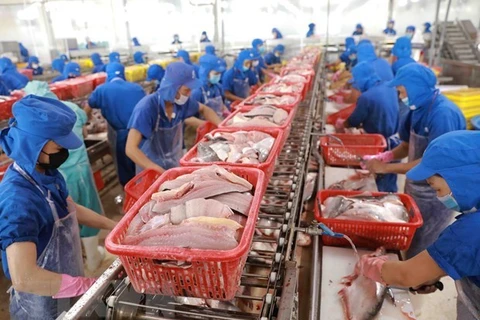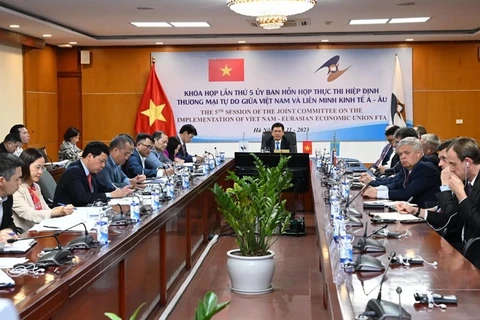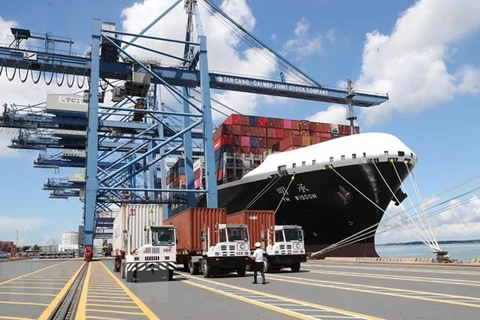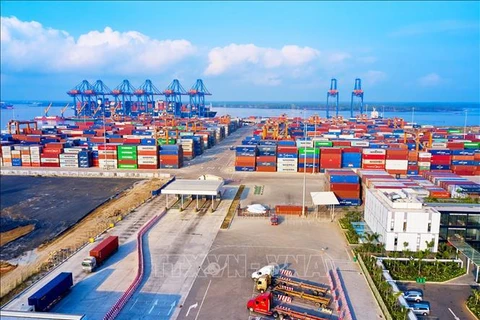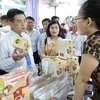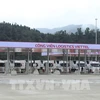 A seminar held in Hanoi on October 31 to discuss how to enhance the implementation of free trade agreements. The Ministry of Industry and Trade is helping provinces improve their capability in this regard. (Photo: VNA)
A seminar held in Hanoi on October 31 to discuss how to enhance the implementation of free trade agreements. The Ministry of Industry and Trade is helping provinces improve their capability in this regard. (Photo: VNA) Vietnam’s participation in several new generation free trade agreements has opened up opportunities for it to expand its export markets, attract foreign investment and fostered its provinces and cities’ economic development and trade.
The country’s provinces and cities have been making efforts to link local exporters with foreign partners, and apprising them about and helping them make use of the trade deals through conferences, seminars, online resources, networking events, and other activities.
Last year, 11 more provinces exported to countries that have signed the Comprehensive and Progressive Agreement for Trans-Pacific Partnership than did in 2021.
Similarly, 44 provinces exported to the UK by making use of the UK – Vietnam Free Trade Agreement in 2022, up 13 in number.
Eleven more provinces exported to markets that are part of the European Union – Vietnam Free Trade Agreement (EVFTA).
According to experts, there is still a lot of opportunity for Vietnam to utilise these markets since, while exports have risen, they have not reached their potential, and the number of exporters remains low.
Several provinces have recorded very low exports to these markets.
This is because many provinces are still not paying sufficient attention to the FTAs, thus not enabling their full utilisation by businesses.
Many activities to support utilisation of FTAs by businesses are carried out broadly without focusing on specific industries or the provinces’ strengths.
According to the Ministry of Industry and Trade, while there have been many conferences and seminars to raise awareness of FTAs, their depth of information does not satisfy businesses’ demands.
There are also not enough Government workers to do justice to these activities, it admitted.
At a seminar held to discuss ways to increase the effectiveness of local level FTA implementation held in Hanoi at the end of October, Nguyen Anh Duong, Director of the Department for General Economic Issues and Integration Studies at the Central Institute for Economic Management, said while many provinces have reached out to relevant authorities and experts to better help businesses make use of FTAs, many exporters are still focusing on immediate problems and see FTAs as something out of their reach.
Do Thi Thuy Huong, member of the executive board of the Vietnam Electronic Industries Association, said provinces in the South with a high concentration of industrial parks have a better approach to guiding businesses on new generation FTAs compared to regions with fewer industrial parks and remote places with few foreign companies.
FTA Index
The ministry is working on the FTA Index with relevant authorities and localities, which will be published by the end of the year to assess cities and provinces’ implementation of free trade agreements.
This will provide more information for investors to make future investment decisions, and for the National Assembly to monitor FTA implementation and provide instructions.
Ngo Chung Khanh, Deputy Director head of the MoIT’s Multilateral Trade Policy Department, said: “Like the Provincial Competitiveness Index, the FTA Index will get provinces to care more about how to best use of various FTAs.”
Duong of the Central Institute for Economic Management said once the FTA Index is published periodically, it would drive provinces to do better with their FTA activities, which would benefit businesses and the national economy.
He told Cong Thuong (Industry and Trade) Newspaper that the ministry should work with experts and localities to create a shared understanding of the index figures, so that relevant agencies and localities will better carry out their tasks.
The ministry is also working on a comprehensive dissemination plan together with other ministries, various other agencies and provinces and cities to provide in-depth information on issues that businesses are interested in, and foster better co-ordination between authorities to avoid overlapping.
It is also developing training courses to produce experts in FTAs, and working with universities to create training programmes.
In the first ten months of the year, Vietnam’s exports were worth 291.28 billion USD, a 7.1% drop year-on-year.
The last two months of the year are expected to see a sharper recovery in exports thanks to positive global economic signs./.
VNA
